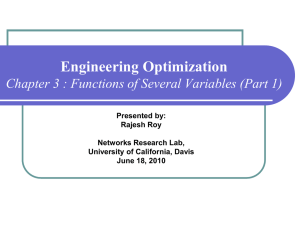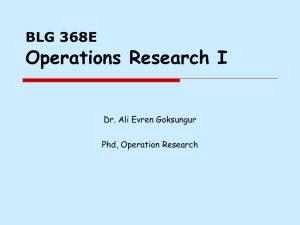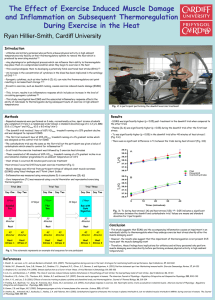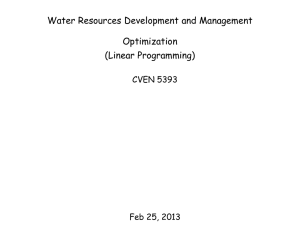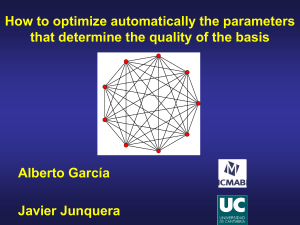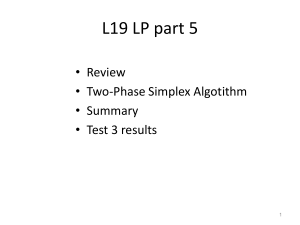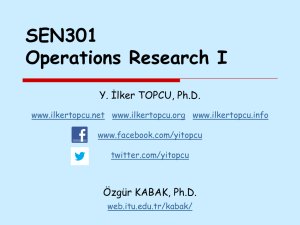Document
advertisement
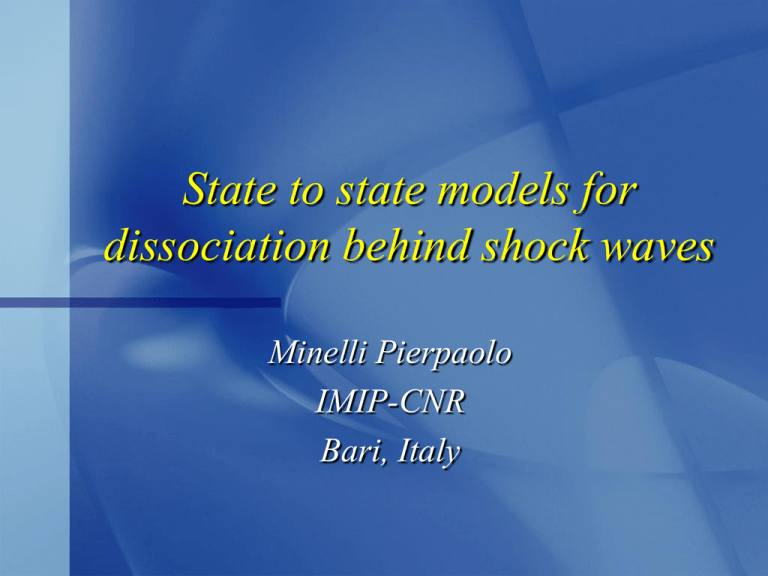
State to state models for dissociation behind shock waves Minelli Pierpaolo IMIP-CNR Bari, Italy Boundary conditions for the kinetic simulation of a shock wave Rankine-Hugoniot equations r0 r1 p0 p1 u0 u1 h0 h1 upstream downstream r1u1 r0 u0 Perfect gas equation p rkT p1 r1u12 p0 r0 u02 m u12 u02 h1 h0 2 2 We use the Rankine-Hugoniot conditions, obtained numerically, to implement the Euler code (which use the full state-to-state kinetic scheme). These results allow us to solve the shock wave problem neglecting transport phenomena (viscosity, heat conduction, etc.). These last outcomes, obtained in a region where transport coefficients are negligible and atomic recombination is irrelevant, are assumed as boundary conditions in the data file of our DSMC code. Collision Models • • • Elastic collisions: VSS model RT collisions: Larsen-Borgnakke method Vibrational and dissociative collision A-M collisions M-M collisions A2 v A A2 v A A2 v A 2 A A mono- quantum transitions A2 v A2 v A2 v 1 A2 v A2 v A2 v A2 v 1 A2 v 1 multi - quantum transitions (dissociation) A2 v A2 v 2 A A2 v Detailed balance principle When a couple of selected particles has been accepted for the collision, the probability associated to the particular state, described by ’A and ’B, will be given by: A , B A , B ;g pA , B T OT For definition of probability must be valid the normalization condition: p , 1 A B All states Aand B In the case of study of the relaxation phenomena, the principle of the detailed balance leads to the following expression: i f ;gg 2 f i; gg2 where i and f represents initial and final states of the molecules. Parker Model Parker has used an empirical non-impulsive potential model that incorporates a small degree of asymmetry to derive an expression for the rotational relaxation time trot. The following approximate expression is obtained: Z rot Z 1 2 3 2 rot T 2 T T 4 T 1 2 where T * is the characteristic temperature of the intermolecular potential and (Zrot)∞ is the limiting value. The value employed in our simulation are: Nitrogen : T 91.5K, Zrot 16 Oxygen : T * 90K, Zrot 14.4 QCT model for A-M collisions (1) In the DSMC simulation, rotation and vibration have been uncoupled. QCT cross sections must be mediated on the rotational spectrum in such a way to obtain, at every fixed reference average rotational temperature, cross sections that depend only from the vibrational level of the molecule. If we consider a generic atom-molecule transition: A2 v , j A A2 v , j A We can write: jmax j j v , j v , j and j 0 jmax v v w j j j j 0 jmax w j j 0 where E v , j kTrot wj e 2 j 1 QCT model for A-M collisions (2) Let consider the following atom-molecule transition: A2 v A A2 v A with ’v = 0,1,…, max, max+1. Generally, it is valid the law of conservation of energy, which, in this case, can be written as: ET OT Ekin Ev Ekin Ev From this equation, it is possible to obtain the only unknown variable E’kin, and so g’ modulus. Pseudo-level (max+1) models the continuum: if the molecule reaches the pseudo-level (max+1), then the two bounded atoms dissociate according to: A2 v A A2 max 1 A 3A QCT and Detailed balance principle We define the following two types of transitions according to the corresponding cross sections: Direct transitions: i i k with k 1,...,i Indirect transitions: i i k with k 1,...,v max i But: i f QCT g 2 f iQCT g2 For this reason, we take into account only QCT results regarding direct collisions and dissociation processes. For cross sections regarding indirect processes, weimpose the principle of detailed balance: i i k; gg2 i k i; gQCT g 2 i i k; Ekin Ekin i k i; Ekin QCT Ekin Molecule-Molecule collision models (1) Two difficulties: • There are not detailed database for these kind of processes! • It is preferred to publish rate coefficients or fit rather than cross section data! It is well known that the rate constants are related to the reaction cross sections through the Laplace transforms in situations where thermal equilibrium may be assumed for the translational degrees of freedom of the reactant molecules. k mr 2 kT 12 3 2 EEe E kT dE 0 It is not simple to invert this Laplace transform, because this operation is illconditionedand, moreover, when a mathematical solution is obtained, it presents, sometimes, strong oscillation or non-physical behaviour. Molecule-Molecule collision models (2) In order to overcome these problems, we have used two types of approach, one for nitrogen case study, and another one for oxygen and hydrogen. Nitrogen Despite the potential capabilities of state-to-state direct description of the chemical kinetics offered by DSMC, phenomenological model for internal state kinetics have been applied to this method as a rule (e.g. Larsen-Borgnakke model). We therefore have developed a simple model for collision between vibrationally excited molecules. Following the approach of Anderson, we use a simple flexible statistical model for translational and internal energy exchange that strictly satisfies detailed balance and incorporates some features of the real cross section. Molecule-Molecule: Nitrogen (1) In the simulation we take into account two kinds of mono-quantum energy exchange collisions: • Vibration-translation (VT) energy exchange v v 1 cVT v Ekin v v v v 1 cVT v 1Ekin v v Detailed balance principle A2 v A2 v A2 v 1 A2 v 22 2 1 1 2 2 , VTv cVT v1, v mr gv , gv; gg2 v 1 gg v 1,mrvg;g vc v 1 2 2 Molecule-Molecule: Nitrogen (2) • Vibration-vibration (VV) energy exchange v v 1 cVV v 1 v Ekin v v 1 For example, in this process A2 v A2 v A2 v 1 A2 v 1 cross sections are proportional, through an adjustable factor cVV, to the product between the two higher vibrational numbers in the considered transition and the kinetic energy of the couple of colliding particles after hit. We have adjusted the model parameters to reproduce the rate coefficients calculated by Billing and Fisher in the temperature range of interest. Molecule-Molecule: Oxygen and Hydrogen For oxygen and hydrogen, we have used a different approach. Practically, the diatom-diatom energy transfer processes are modelled by fitting directly the rate coefficients, of Billing and Kolesnick for oxygen and of Matveyev and Silakov for hydrogen, by downhill simplex method. This method is due to Nelder and Mead and it requires only function evaluations. A simplex is the geometrical figure consisting, in N dimensions, of N+1 points (or vertices) and all their interconnecting line segments, polygonal faces, etc. For multidimensional minimization, the best we can do is give our algorithm a starting guess, that is, an N-vector of independent variables as the first point to try. The algorithm is then supposed to make its own way downhill through the unimaginable complexity of an N-dimensional topography, until it encounters a (local, at least) minimum. The downhill simplex method must be started not just with a single point, but with N+1 points, defining an initial simplex. Downhill simplex method (2) Mono-quantum transitions (VT) are included along with quasi-resonant VV energy transfer. The cross sections for these processes are assumed to be of the form: EexpE E being the collision energy and , and the fitting parameter for each transition. The crosssections for the backward transitions are determined by application of the detailed balance principle. We decide to cut the cross sections at Emax=3eV. The best fit parameters are able to reproduce the calculated rate coefficients very well in the temperature range (300-10000K). Downhill simplex method results (1) 10 2 10 0 10 2 10 0 10 0 H ( v)+H ( w+1) ---> H ( v+1)+H ( w) -2 10 -4 10 v=1 v=5 v=10 v=14 -6 10 -8 10 0 0,5 1 1,5 E (eV) (a) 2 2,5 3 2 v=1 ; w=0 v=5 ; w=4 v=10 ; w=9 v=14 ; w=13 -2 2 2 H2( v)+H2( 0) ---> H2( v-1)+H2( 0) -4 2 10 ( ) 2 ( ) 10 2 10 ( ) -2 10 2 -1 H2( v)+H2( 5) ---> H2( v-1)+H2( 5) 10 -6 10 -8 -3 10 v=1 v=5 v=10 v=14 -4 10 -5 10 0 0,5 1 1,5 E (eV) (b) 2 2,5 3 0 0,5 1 1,5 E (eV) 2 2,5 (c) (a) VT cross sections obtained by Downhill Simplex Method for a process in which molecule, that do not change vibrational level, is at the ground state. (b) VT cross sections obtained by Downhill Simplex Method for a process in which molecule, that do not change vibrational level, is not at the ground state. (c) VV cross sections obtained by Downhill Simplex Method for various processes. 3 Downhill simplex method results (2) Downhill Sim plex Method Matvey ev and Silakov -14 10 Downhill Sim plex Method Matvey ev and Silakov -13 6 10 10 Downhill Sim plex Method Matvey ev and Silakov -12 -15 2 2 -15 2 2 2 2 -15 7 10 H ( 14)+H ( 14) ---> 2H+H( 13) -13 3 3 8 10 H ( 10)+H ( 10) ---> H ( 11)+H ( 9) -13 5 10 9 10 2 2 2 -1 2 -1 2 K(cm *s ) H ( 1)+H ( 1) ---> H ( 2)+H ( 0) K(cm *s ) 3 -1 K(cm *s ) 9 10 -13 8 10 -13 4 10 -13 7 10 -15 6 10 -13 6 10 -13 -15 3 10 5 10 0 2000 4000 6000 T(K) (a) 8000 10000 0 2000 4000 6000 T(K) (b) 8000 10000 0 2000 4000 6000 T(K) 8000 10000 (c) (a), (b), (c) Comparison between rate coefficients obtained by Downhill Simplex Method and that obtained by fit from Matveyev and Silakov. 2 10 1 10 -8 10 -9 3 2 ( ) -1 10 K(cm *s ) Downhill simplex method results (3) Downhill Simplex Method QCT 10 Downhill Simplex Method QCT 0 H (14)+H ---> 3H H (14)+H ---> 3H 2 10 2 -1 10 0 0,5 1 1,5 2 2,5 3 -10 0 2000 4000 E (eV) (a) 6000 8000 10000 T(K) (b) (a) Comparison between cross sections obtained by Downhill Simplex Method and by QCT (b) Comparison between rate coefficients, relative to the same process of (a), obtained by Downhill Simplex Method and by QCT. Downhill simplex method results (4) -3 10 10 -14 10 -15 -4 3 2 ( ) -1 K(cm *s ) 10 Downhill Simplex Met hod QCT -5 10 Downhill Simplex Method QCT 10 H (0)+H ---> 3H -16 H (0)+H ---> 3H 2 2 -6 10 10 0 0,5 1 1,5 2 2,5 3 -17 0 2000 4000 8000 10000 T(K) E (eV) (a) 6000 (b) (a) Comparison between cross sections obtained by Downhill Simplex Method and by QCT (b) Comparison between rate coefficients, relative to the same process of (a), obtained by Downhill Simplex Method and by QCT. Downhill simplex method results (5) 10 2 Downhill Simplex Method QCT Downhill Simplex Method QCT -10 5 10 H (14)+H ---> H (13)+H 2 H (14)+H ---> H (13)+H 2 2 2 10 10 1 3 2 ( ) -1 K(cm *s ) -10 4 10 -10 3 10 -10 0 2 10 0 0,5 1 1,5 E (eV) (a) 2 2,5 3 0 2000 4000 6000 8000 10000 T(K) (b) (a) Comparison between cross sections obtained by Downhill Simplex Method and by QCT (b) Comparison between rate coefficients, relative to the same process of (a), obtained by Downhill Simplex Method and by QCT. Molecule-Molecule: dissociation • Multi-quantum VT transition Dissociation cross sections from lower levels are equal to mono-quantum cross section from the last bounded level vmax to the pseudo-level vdiss, calculated at the same total energy, dampened from a negative exponential factor. v , v diss , v ; Etot max , v diss , v ; Etot e E max E v kU Such damping factor is called vibrational favouring. Finally, A2 max A2 v multi-quantum 2 A A2 v we can write forVTdissociative through If we consider the following reaction: reactions, transition, the following expression of cross section: Cross section can be written as: max v , v diss , v ; Etot E E cVTE diss eEkin kU v ,max v diss , v ; Etot Ekin E v cmax VT diss kin kin E E Shock wave produced in pure Nitrogen (I) 16 1 10 -1 15 8 10 15 6 10 1 10 -2 -2 at 6 10 (a) 15 4 10 density , cm -3 8 10 -2 4 10 (b) -2 2 10 15 2 10 0 0 10 0 0 10 -200 0 200 400 600 x/ 800 1000 1200 -200 0 200 400 600 x/ 800 1000 1200 In Fig. (a) and (b) we report, the total number density and the atomic molar fraction. The spatial scale is always expressed using the upstream mean free path as a unit. We can observe the effect of the thermal relaxation on the gas number density. The compression ratio behind the shock waves reaches rapidly the value of 6 valid for strong shocks in a gas of rigid rotors. From here it grows slowly to the value of 8, following the slow vibrational relaxation. Further increase of the compression ratio is due to the increase of the atom fraction. Shock wave produced in pure Nitrogen (II) 4 4 1,2 10 1,2 10 T T 3 8,0 10 3 8,0 10 T T,K 01 (c) 3 4,0 10 T,K rot 3 T T 4,0 10 (d) rot T 01 0 0,0 10 -20 0 0 20 40 x/ 60 80 0,0 10 -200 0 200 400 600 x/ 800 1000 1200 In Fig. (c) and (d) we report the three ‘temperature’ which are relevant for this study: i.e. the static translational temperature T, the rotational temperature Trot and the T01 vibrational temperature 1 T01 01k ln n1 n0 It can be seen that the sudden jump in T is rapidly followed by slower jump for Trot. The vibrational relaxation follows with a longer relaxation time. Shock wave produced in pure Nitrogen (III) 0 0 10 10 x/=-138 x/=17 x/=26 x/=47 x/=74 x/=145 x/=850 -1 10 -2 10 -3 10 10 -2 10 (a) (a) -3 10 -4 10 -5 10 (b) -4 10 10 x/=-138 x/=5 x/=11 x/=17 x/=23 x/=32 -1 -5 0 2 4 Energy , eV 6 8 0 1 2 3 4 Energy , eV 5 6 7 This slower relaxation is also affected by its mesoscopic structure in terms of the vibrational distribution functions (vdf). In Fig. (a) we report some of these vdf’s at different positions along the flow. It can be noticed that the vdf is sensibly non-Boltzmann due to the highly effective VV/VT processes. In Fig. (b) is plotted the distribution of (classical) rotational energy. The different curves refer to different positions along the shock front and during the rotational relaxation. It can be seen the strong deviation from the equilibrium distribution during relaxation. Shock wave produced in pure Nitrogen (IV) 0 5 10 5 10 5 v , cm/s 4 10 x/=-138 x/=5 x/=11 x/=14 -1 10 x/=17 x/=20 x/=32 x/=1146 5 3 10 -2 (c) (a) 5 2 10 10 (d) -3 10 5 1 10 -4 0 0 10 -200 0 200 400 600 x/ 800 1000 1200 10 0 0 10 5 2 10 5 4 10 v , cm/s 5 6 10 5 8 10 In Fig. (c) we report the velocity along the flow, while in Fig. (d) we report the translational distribution function at different positions along the shock front. At the two extreme points the distribution are equilibrium distributions at the upstream and downstream temperatures, respectively. At the points in between a sensible deviation from the Maxwell one is observed, in the form of a ‘tail’. Even if the effect of such a deviation on macroscopic quantities is probably small under typical conditions, these plots show the degree of detail which our model can achieve in describing the shock thickness. Conclusions In our work, we have studied by direct simulation the vibrational and dissociation kinetics in a strong normal shock wave in molecular gases. The main achievement of our work in comparison with previous studies is the self-consistent modelling of translational, rotational and vibrational kinetics of a diatomic gas which is undergoing dissociation in the shock wave. Furthermore, we used only data in form of cross sections from the literature, or calculated by molecular dynamics methods. Results show that the vibrational, rotational and translational distribution functions can significantly deviate from the equilibrium one in the shock region. Such deviations affect in turn the rate of elementary processes. Improvements Critical points: • Computational cost • There are few data for molecule-molecule interaction In order to overcome the first problem we are led to consider a parallelization of the code. This will also permit to extend the calculations to 2D. This is necessary in order to couple the DSMC with fluid-dynamics codes for the simulation of near-continuum flows. A hybrid particle-continuum computational method would be more accurate in order to describe re-entry phenomena, paying attention to the information exchange at the interface between the particle and the continuum domain. Finally we are studying how to couple DSMC with a PIC method in order to reproduce plasma phenomena or shock waves in ionized gases.


